[English] 日本語
 Yorodumi
Yorodumi- PDB-5ydz: structure of endo-lysosomal TRPML1 channel inserting into amphipo... -
+ Open data
Open data
- Basic information
Basic information
| Entry | Database: PDB / ID: 5ydz | |||||||||
|---|---|---|---|---|---|---|---|---|---|---|
| Title | structure of endo-lysosomal TRPML1 channel inserting into amphipol: state 1 | |||||||||
 Components Components | mammalian endo-lysosomal TRPML1 channel | |||||||||
 Keywords Keywords |  MEMBRANE PROTEIN / mTRPML1 / MEMBRANE PROTEIN / mTRPML1 /  mucolipidosis type IV / structual comparisons / combined regulation mechanism mucolipidosis type IV / structual comparisons / combined regulation mechanism | |||||||||
| Function / homology |  Function and homology information Function and homology informationTransferrin endocytosis and recycling / calcium ion export / positive regulation of lysosome organization / intracellularly phosphatidylinositol-3,5-bisphosphate-gated monatomic cation channel activity / NAADP-sensitive calcium-release channel activity / phagosome maturation / cellular response to pH / ligand-gated calcium channel activity /  TRP channels / endosomal transport ...Transferrin endocytosis and recycling / calcium ion export / positive regulation of lysosome organization / intracellularly phosphatidylinositol-3,5-bisphosphate-gated monatomic cation channel activity / NAADP-sensitive calcium-release channel activity / phagosome maturation / cellular response to pH / ligand-gated calcium channel activity / TRP channels / endosomal transport ...Transferrin endocytosis and recycling / calcium ion export / positive regulation of lysosome organization / intracellularly phosphatidylinositol-3,5-bisphosphate-gated monatomic cation channel activity / NAADP-sensitive calcium-release channel activity / phagosome maturation / cellular response to pH / ligand-gated calcium channel activity /  TRP channels / endosomal transport / phagocytic cup / intracellular vesicle / autophagosome maturation / monoatomic cation transmembrane transport / localization / monoatomic cation channel activity / release of sequestered calcium ion into cytosol / cellular response to calcium ion / cell projection / calcium ion transmembrane transport / phagocytic vesicle membrane / late endosome / late endosome membrane / protein homotetramerization / TRP channels / endosomal transport / phagocytic cup / intracellular vesicle / autophagosome maturation / monoatomic cation transmembrane transport / localization / monoatomic cation channel activity / release of sequestered calcium ion into cytosol / cellular response to calcium ion / cell projection / calcium ion transmembrane transport / phagocytic vesicle membrane / late endosome / late endosome membrane / protein homotetramerization /  adaptive immune response / adaptive immune response /  lysosome / lysosome /  receptor complex / lysosomal membrane / intracellular membrane-bounded organelle / receptor complex / lysosomal membrane / intracellular membrane-bounded organelle /  lipid binding / lipid binding /  Golgi apparatus / Golgi apparatus /  nucleoplasm / nucleoplasm /  membrane / identical protein binding / membrane / identical protein binding /  plasma membrane plasma membraneSimilarity search - Function | |||||||||
| Biological species |   Mus musculus (house mouse) Mus musculus (house mouse) | |||||||||
| Method |  ELECTRON MICROSCOPY / ELECTRON MICROSCOPY /  single particle reconstruction / single particle reconstruction /  cryo EM / Resolution: 5.8 Å cryo EM / Resolution: 5.8 Å | |||||||||
 Authors Authors | Yang, M. / Gao, N. | |||||||||
| Funding support |  China, 2items China, 2items
| |||||||||
 Citation Citation |  Journal: Protein Cell / Year: 2017 Journal: Protein Cell / Year: 2017Title: Cryo-EM structures of the mammalian endo-lysosomal TRPML1 channel elucidate the combined regulation mechanism. Authors: Sensen Zhang / Ningning Li / Wenwen Zeng / Ning Gao / Maojun Yang /  Abstract: TRPML1 channel is a non-selective group-2 transient receptor potential (TRP) channel with Ca permeability. Located mainly in late endosome and lysosome of all mammalian cell types, TRPML1 is ...TRPML1 channel is a non-selective group-2 transient receptor potential (TRP) channel with Ca permeability. Located mainly in late endosome and lysosome of all mammalian cell types, TRPML1 is indispensable in the processes of endocytosis, membrane trafficking, and lysosome biogenesis. Mutations of TRPML1 cause a severe lysosomal storage disorder called mucolipidosis type IV (MLIV). In the present study, we determined the cryo-electron microscopy (cryo-EM) structures of Mus musculus TRPML1 (mTRPML1) in lipid nanodiscs and Amphipols. Two distinct states of mTRPML1 in Amphipols are added to the closed state, on which could represent two different confirmations upon activation and regulation. The polycystin-mucolipin domain (PMD) may sense the luminal/extracellular stimuli and undergo a "move upward" motion during endocytosis, thus triggering the overall conformational change in TRPML1. Based on the structural comparisons, we propose TRPML1 is regulated by pH, Ca, and phosphoinositides in a combined manner so as to accommodate the dynamic endocytosis process. | |||||||||
| History |
|
- Structure visualization
Structure visualization
| Movie |
 Movie viewer Movie viewer |
|---|---|
| Structure viewer | Molecule:  Molmil Molmil Jmol/JSmol Jmol/JSmol |
- Downloads & links
Downloads & links
- Download
Download
| PDBx/mmCIF format |  5ydz.cif.gz 5ydz.cif.gz | 226.2 KB | Display |  PDBx/mmCIF format PDBx/mmCIF format |
|---|---|---|---|---|
| PDB format |  pdb5ydz.ent.gz pdb5ydz.ent.gz | 145.1 KB | Display |  PDB format PDB format |
| PDBx/mmJSON format |  5ydz.json.gz 5ydz.json.gz | Tree view |  PDBx/mmJSON format PDBx/mmJSON format | |
| Others |  Other downloads Other downloads |
-Validation report
| Arichive directory |  https://data.pdbj.org/pub/pdb/validation_reports/yd/5ydz https://data.pdbj.org/pub/pdb/validation_reports/yd/5ydz ftp://data.pdbj.org/pub/pdb/validation_reports/yd/5ydz ftp://data.pdbj.org/pub/pdb/validation_reports/yd/5ydz | HTTPS FTP |
|---|
-Related structure data
| Related structure data |  6823MC  6824C  6825C 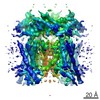 6826C  5ye1C  5ye2C  5ye5C M: map data used to model this data C: citing same article ( |
|---|---|
| Similar structure data |
- Links
Links
- Assembly
Assembly
| Deposited unit | 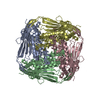
|
|---|---|
| 1 |
|
- Components
Components
| #1: Protein | Mass: 65573.617 Da / Num. of mol.: 4 Source method: isolated from a genetically manipulated source Source: (gene. exp.)   Mus musculus (house mouse) / Gene: Mcoln1 / Production host: Mus musculus (house mouse) / Gene: Mcoln1 / Production host:   Homo sapiens (human) / References: UniProt: Q99J21 Homo sapiens (human) / References: UniProt: Q99J21 |
|---|
-Experimental details
-Experiment
| Experiment | Method:  ELECTRON MICROSCOPY ELECTRON MICROSCOPY |
|---|---|
| EM experiment | Aggregation state: PARTICLE / 3D reconstruction method:  single particle reconstruction single particle reconstruction |
- Sample preparation
Sample preparation
| Component | Name: mammalian endo-lysosomal TRPML1 channel inserting into amphipol Type: ORGANELLE OR CELLULAR COMPONENT / Entity ID: all / Source: RECOMBINANT |
|---|---|
| Source (natural) | Organism:   Mus musculus (house mouse) Mus musculus (house mouse) |
| Source (recombinant) | Organism:   Homo sapiens (human) Homo sapiens (human) |
| Buffer solution | pH: 7.4 |
| Specimen | Embedding applied: YES / Shadowing applied: NO / Staining applied : NO / Vitrification applied : NO / Vitrification applied : YES : YES |
| EM embedding | Material: Amorphous ice |
Vitrification | Cryogen name: ETHANE |
- Electron microscopy imaging
Electron microscopy imaging
| Experimental equipment | 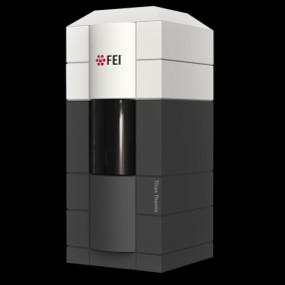 Model: Titan Krios / Image courtesy: FEI Company |
|---|---|
| Microscopy | Model: FEI TITAN KRIOS |
| Electron gun | Electron source : :  FIELD EMISSION GUN / Accelerating voltage: 300 kV / Illumination mode: FLOOD BEAM FIELD EMISSION GUN / Accelerating voltage: 300 kV / Illumination mode: FLOOD BEAM |
| Electron lens | Mode: BRIGHT FIELD Bright-field microscopy Bright-field microscopy |
| Image recording | Electron dose: 50 e/Å2 / Film or detector model: GATAN K2 SUMMIT (4k x 4k) |
- Processing
Processing
| EM software | Name: RELION / Version: 2 / Category: 3D reconstruction |
|---|---|
CTF correction | Type: PHASE FLIPPING AND AMPLITUDE CORRECTION |
| Symmetry | Point symmetry : C4 (4 fold cyclic : C4 (4 fold cyclic ) ) |
3D reconstruction | Resolution: 5.8 Å / Resolution method: FSC 0.143 CUT-OFF / Num. of particles: 167000 / Symmetry type: POINT |
 Movie
Movie Controller
Controller


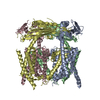
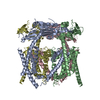

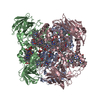

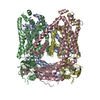

 PDBj
PDBj